Woodpeckers are interesting birds from the Picidae family, including wrynecks, piculets and sapsuckers. The Picidae family is large, consisting of over 230 birds. Woodpeckers are distributed across much of the world except most of Australasia and the polar regions.
Woodpeckers are well known for their ability to excavate their own nesting sites. Wrynecks lack this ability and have to locate pre-existing nesting cavities.
For the most part, woodpeckers are elusive and solitary birds. However, woodpeckers are often heard and not seen with the naked eye, as their characteristic pecking or drumming sound is very distinctive!
Many woodpeckers breed in Europe, but the UK is home to just three resident species; the Great spotted, Lesser-spotted and Eurasian green woodpeckers and one rare vagrant from Europe, the Eurasian wryneck.
This is a complete guide to all of the woodpeckers that can be found in the UK.
More common British species of Woodpeckers
You’re most likely to see these two species of woodpeckers, depending on where you are in the UK.
Great Spotted Woodpecker
Dendrocopos major
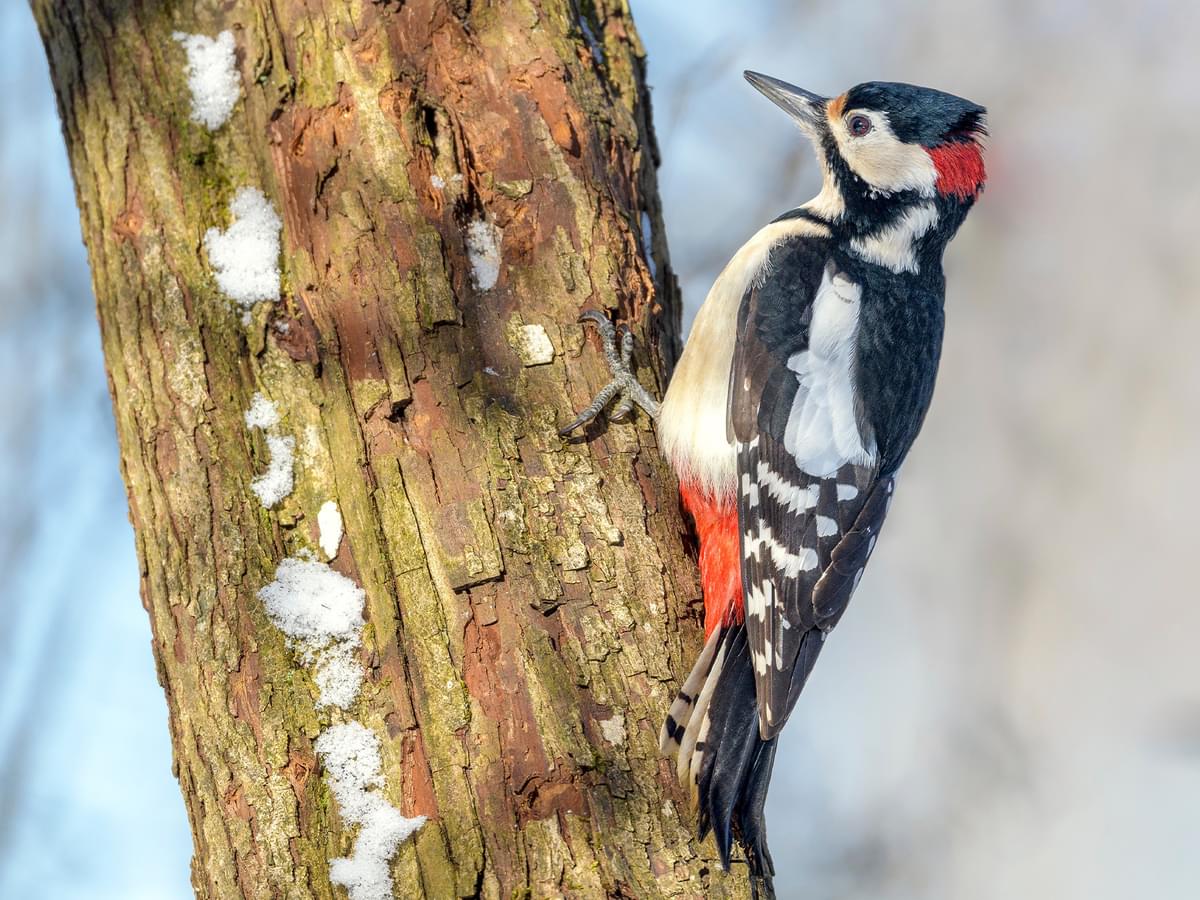
Length
23-26cm
Wingspan
38-44cm
Weight
70-98g
Great Spotted Woodpecker
The Greater Spotted woodpecker is a beautiful bird with black and white spotted wings, contrasting white and black plumage and a distinctive red undertail. The male also has a bright red cap or crown.
These elusive birds are common throughout the UK and are most abundant in the deciduous and ancient woodland of England and Wales. They’re absent from north Scotland and much of Northern Ireland. Small populations are found on the Isle of Man.
Like many woodpeckers, the Great Spotted woodpecker is an elusive creature that is most likely to be seen hanging off trees. They prefer to remain isolated from humans but are sometimes seen nesting in manmade structures near rural settlements.
Despite deforestation, the Great Spotted woodpeckers population has increased by a massive 300% since the 1970s. The reasons why are somewhat unclear, but conservationists believe the species has been suited by an increase in dead trees, particularly those resulting from Dutch Elm Disease. There are at least 140,000 pairs of Great Spotted woodpeckers in the UK, and they don’t migrate. That makes them the most common woodpecker in the UK.
The Great Spotted woodpecker is well-known for its ‘drumming’ display, a territorial behaviour that sees the male woodpecker hammer at a tree or wooden structure to create loud drumming sounds. These woodpeckers can hammer wood with their beaks at a rate of 16 times a second, at a velocity that no human would be able to tolerate without severe concussion.
In rare circumstances, male Great Spotted Woodpeckers can drum up to an impressive rate of 40 strikes per second.
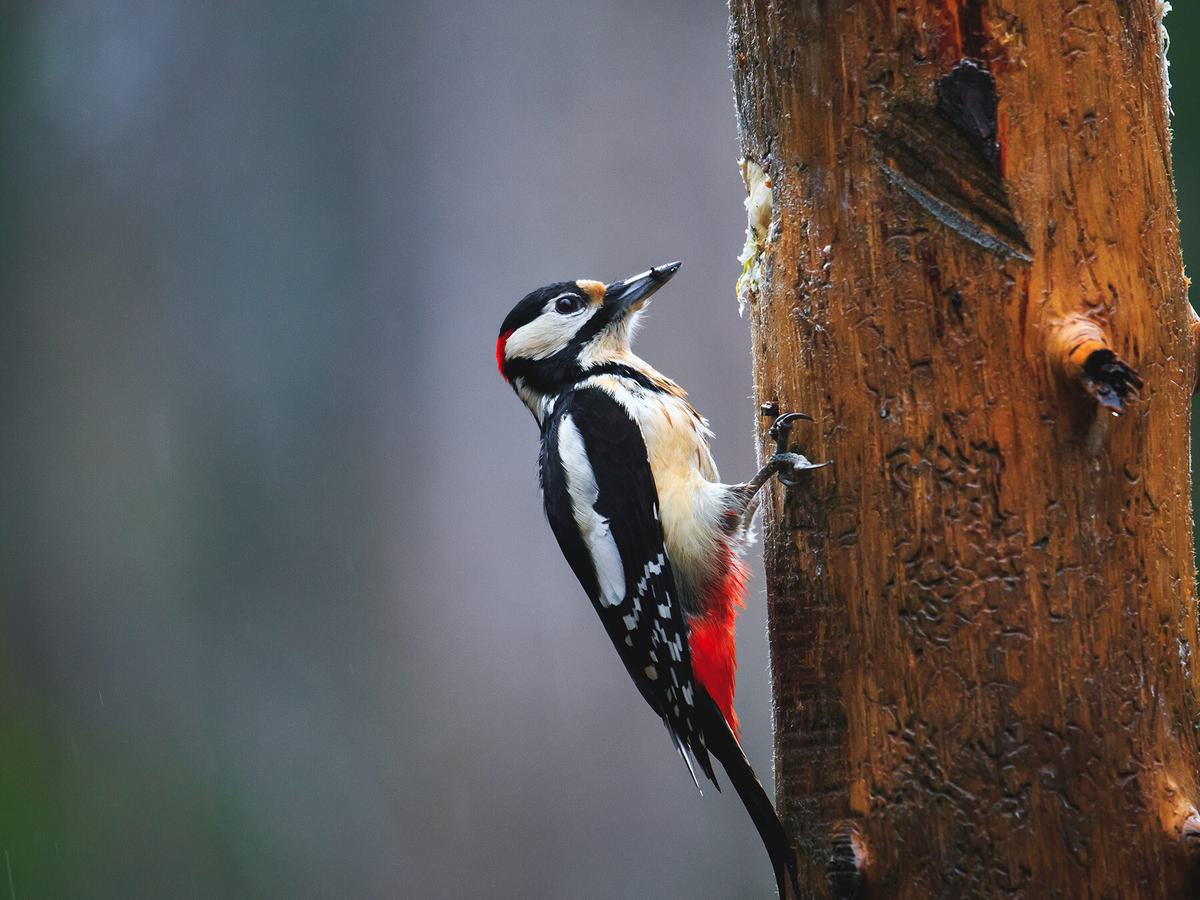
Great Spotted Woodpecker foraging on a tree
Appearance
Great Spotted woodpeckers are medium-sized birds measuring 20 to 24cm (7.9 to 9.4in) long, weighing 70 to 98g (2.5 to 3.5 oz). They have a wingspan of 34 to 39cm (13 to 15in). Their main upperparts are blue-black, with white sides and stripes across the face and neck.
They have white shoulder patches and red crowns, which are more significant in the male, who also has a red patch on the nape. The underparts are predominately white, with a red patch at the base of the tail. The rear of the wings and tail are barred or spotted, which gives the bird its name.
Female Great Spotted Woodpeckers are similar but are less red and have a brown tinge to the otherwise-white parts of the plumage.
As you might expect, these woodpeckers have rather long, pointed bills. Their heads are also slender, which helps absorb the shock of pecking and drumming.
Overall, the Great Spotted woodpecker is a striking and beautiful bird. Its distinctive appearance makes it fairly easy to spot if you’re lucky enough to be around one. If you spot a bird with red and black and white stripes, it’s highly likely to be a Great Spotted woodpecker (or rarely, a Lesser Spotted woodpecker!)
European Green Woodpecker
Picus viridis
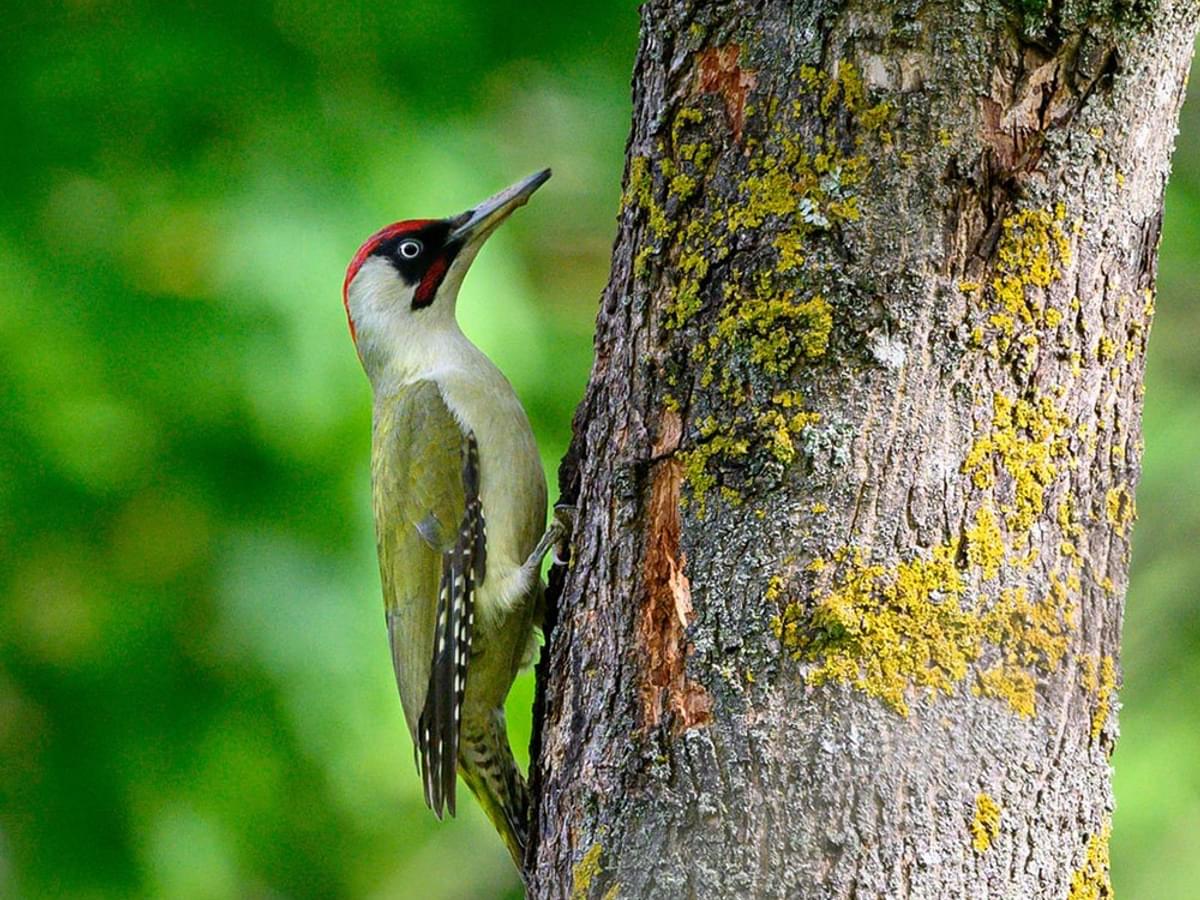
Length
30-36cm
Wingspan
40-42cm
Weight
180-220g
Green Woodpecker
The largest woodpecker in the UK, the Eurasian Green woodpecker is very different to the Great spotted woodpecker in terms of colouration. Green woodpeckers are perhaps even shyer than the Great Spotted woodpecker, and they rarely drum on trees. However, they do have a distinctive and loud laughing call that rings deep into the forest.
Green woodpeckers share similar habitats to their spotted relative, including ancient, mature woodlands, with a slight preference for deciduous trees rather than conifers. Like most woodpeckers, these birds are cavity nesters and will happily excavate their own nest in a healthy or rotten tree.
Like Great Spotted woodpeckers, Green woodpeckers are much more common in Wales and England than in Scotland, where they’re almost absent from the Highlands and Scottish Islands. Moreover, they’re almost entirely absent from the island of Ireland. These are distinctly European birds, as Europe contains some 75% of their entire population.
Green woodpeckers’ diets consist mostly of ants, which they hoover up from the ground. This is when you’re most likely to see them - when they descend from the tree canopy to feed during the day.
There are around 52,000 pairs of Green woodpeckers in the UK. The Green woodpecker population has doubled since the early 20th-century, but recent studies show that it’s beginning to decline again.
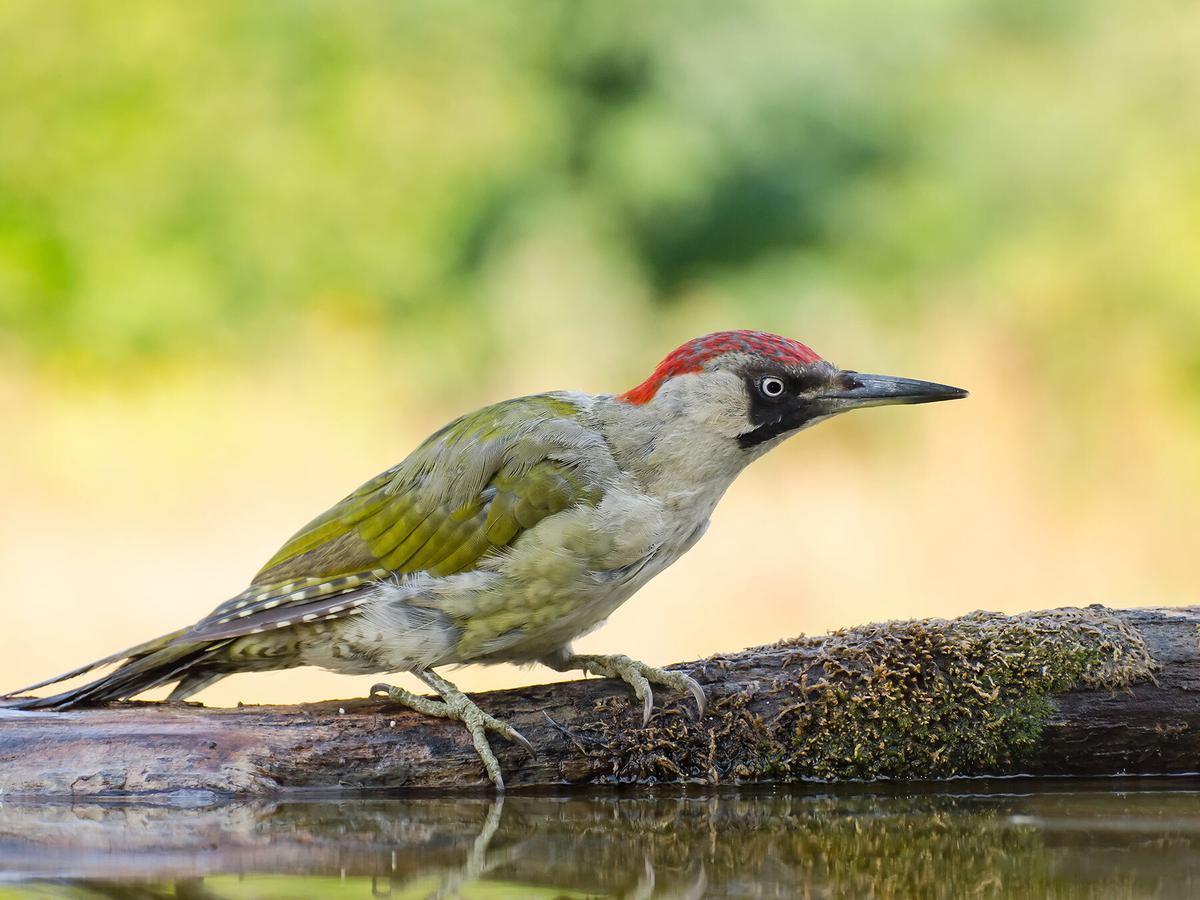
European Green Woodpecker on the ground
Appearance
Green woodpeckers measure 30 to 36cm (12 to 14 in) in length with a wingspan of around 45 to 51cm. They weigh around 180g. This makes them slightly larger than the Great spotted woodpecker, albeit marginally. The Green woodpecker has olive-to-dark green wings, a yellow rump and a red crown and nape.
Juveniles look markedly different, as they’re very spotty and streaked, especially across the wings. Their bills are long and sharp, and their heads are a similar shape to many woodpeckers. This smooth, elongated head shape helps the woodpecker to peck and hammer at wood without damaging its brain.
Males are brighter overall with a black ‘moustache’ underneath their black facial plumage. They also have a brighter, bolder and larger red crown. The contrast between green and red makes the Green woodpecker somewhat easy to spot if there’s one in the vicinity. They’re often seen visiting the forest floor to feed before flying up to their treetop perch or nest.
Less common woodpecker species in the UK
The following two species of woodpeckers are uncommon in the UK.
Lesser Spotted Woodpecker
Dryobates minor
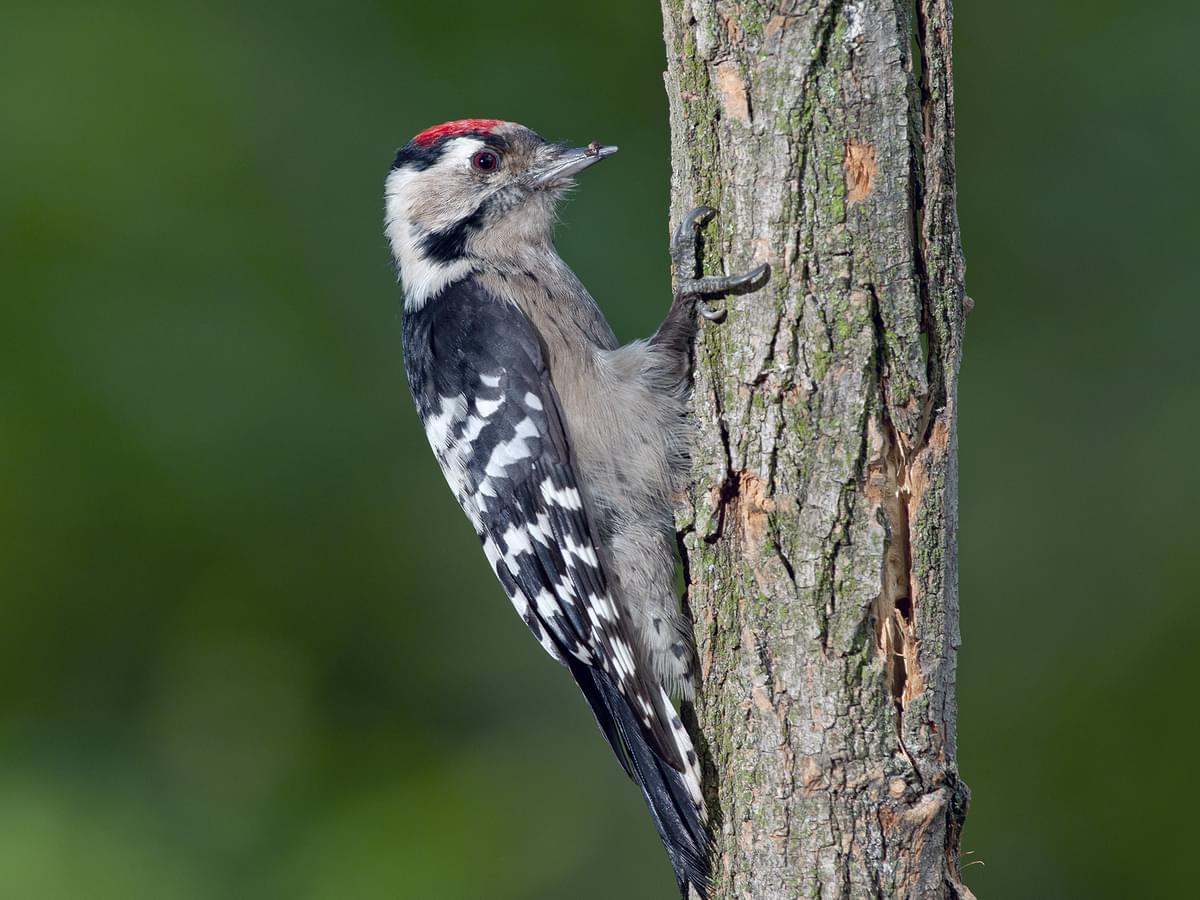
Length
14-16cm
Wingspan
25-27cm
Weight
17-25g
Lesser Spotted Woodpecker
The Lesser Spotted woodpecker is much less common in the UK than its larger relative. Despite evident similarities, the Lesser Spotted woodpecker is now placed in the Dryobates genus rather than Picus, which contains both the Eurasian Green and Greater Spotted woodpeckers.
In fact, there are an estimated 1,000 to 2,000 pairs only, and they’re placed on the UK Birds of Conservation Concern Red List. This once-abundant native species is now amongst the UK’s most rapidly declining species of birds. The main causes behind this rapid decline are unclear - it might be that the growing populations of other larger species of woodpeckers are forcing this small species from its typical habitats.
Like other UK woodpeckers, the Lesser Spotted woodpecker is most common in the south of England, primarily the southeast. They’re seldom spotted in the north and very rarely in Scotland. They’re also entirely absent from the island of Ireland.
These small birds much prefer ancient, mature woodlands with an abundance of old rotten trees. They’re cavity nesters, like most woodpeckers, and make their home in soft tree trunks. Like the Great Spotted, this woodpecker also drums to announce its presence in a territory, but naturally, due to its size, the drumming is much softer.
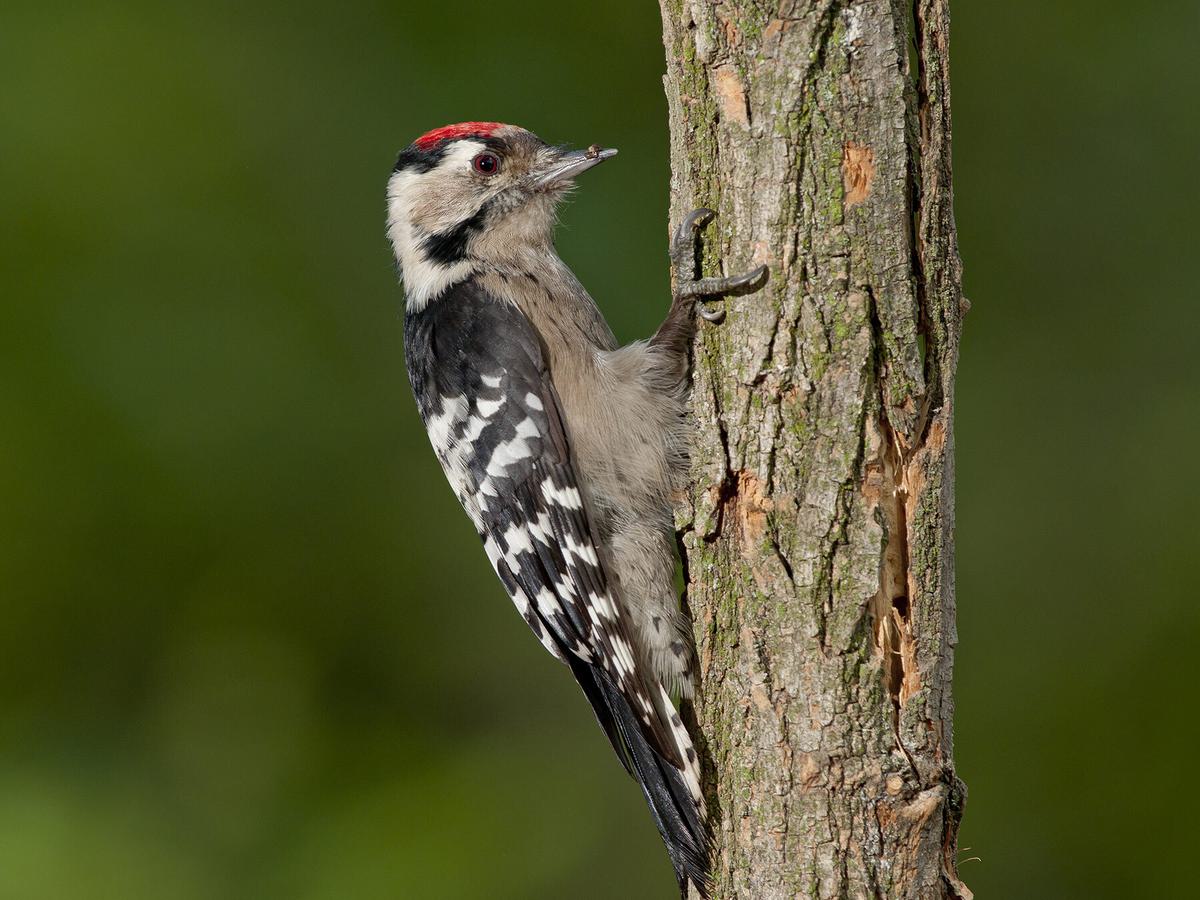
Lesser Spotted Woodpecker perched on a tree
Appearance
These are the smallest woodpeckers in Europe, measuring just 14 to 16.5cm (5.5 to 6.5in) long with a wingspan of 24 to 29cm (9.4 to 11.4in). They weigh around 17 to 25g. Their tiny size makes them very tough to spot amongst their dense woodland habitats. However, these are stout and stocky birds for their small size and they have a strong, sharp beak.
In terms of plumage, the Lesser and Great Spotted woodpeckers are alike. However, the Lesser Spotted woodpecker is primarily black with white bars on the wings, which are more pronounced than the Greater. Bars extend across all the wings and are particularly distinctive when the birds are in flight.
Males have a distinctive red crown on their heads, which is mostly lacking on the female. The easiest way to tell this woodpecker apart from the Greater Spotted woodpecker is from its size - it’s much, much smaller. Moreover, the wing bars are broader and more pronounced.
Wryneck
Jynx torquilla
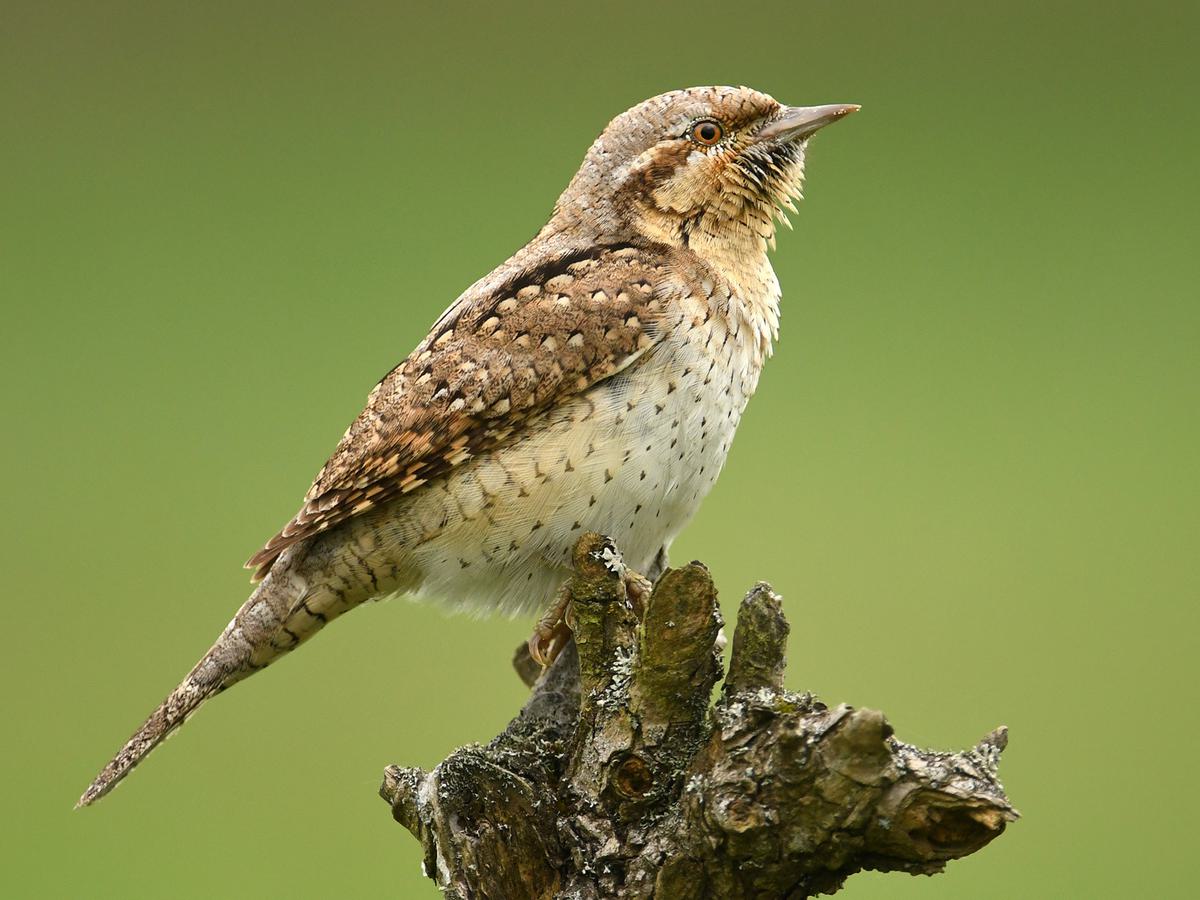
Length
16-18cm
Wingspan
25-27cm
Weight
30-45g
Wryneck
The Eurasian wryneck belongs to the genus Jynx, a word which is etymology related to the homonym “jinx” - read on to find out why!
This small woodpecker looks markedly different and is unique with regard to its behaviour. Firstly, it doesn’t excavate its own nesting cavities, instead choosing to nest in pre-existing holes.
Though it was once abundant, this bird no longer breeds in the UK, and only a couple of hundred are thought to pass through on their migratory journey to and from just south of the Sahara in Africa. In fact, there are very few wryneck sightings in the UK each year, even though the bird is relatively abundant just north in Scandinavia. However, while rare in the UK, wrynecks are common throughout much of Europe and North Africa.
These well-camouflaged woodpeckers spend much of their time, in contrast to other woodpeckers. Feeding primarily on ants and other small insects, they’re usually seen foraging on the forest floor.
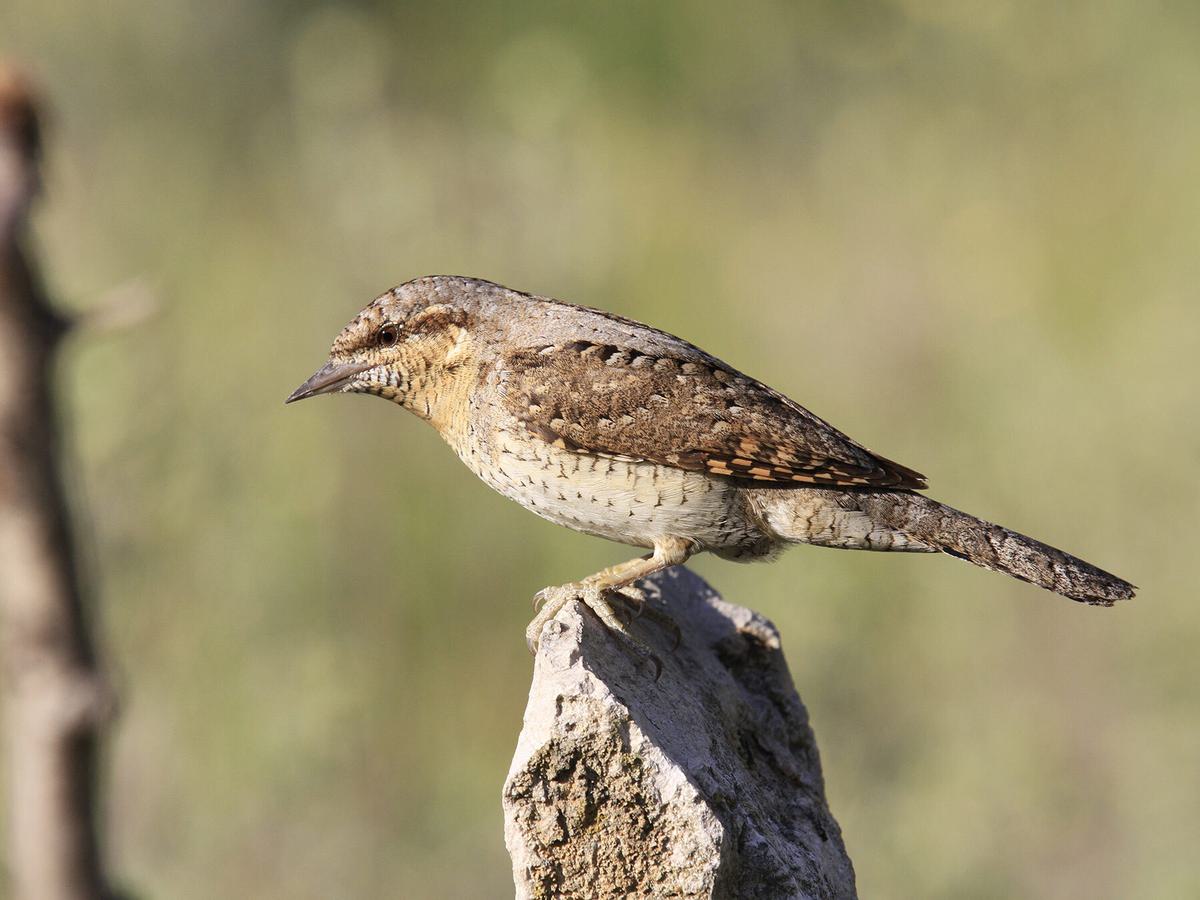
Eurasian Wryneck perched on a post
Appearance
The Eurasian wryneck is a slim, long bird, measuring 17 cm (6.7in) in length with a wingspan of around 25 to 27cm. It weighs between 26 and 50g (0.92 to 1.76oz). The wryneck is a camouflaged brown with lighter mottling and a white band running down its middle. While these birds don’t look much like woodpeckers, they share the same skeletal structure as woodpeckers, including complex vertebrae.
The most distinctive behaviour of the wryneck is its snake mimicry. When provoked, threatened or attacked, the wryneck uses its slender form and neck to impersonate a snake, writhing and twisting to scare away its assailant. They even hiss like snakes! Natural selection favoured wrynecks that looked more “snake-like”, which slowly evolved into a complex self-defence strategy.
In medieval Europe, wrynecks were heavily associated with witchcraft. Their snake mimicry was believed to be connected to dark magic. An encounter with a wryneck might result in them putting a spell on you - a jinx. The 20th-century word jinx is derived from Jynx, the genus of the birds that includes the wrynecks.
What are woodpeckers?
There are some 230 to 240 woodpeckers in the family Picidae, including piculets, wrynecks, and sapsuckers.
Woodpeckers are common in the Americas, Europe, Asia and Africa, but are absent from Australia, New Zealand, Guinea and Madagascar. They breed as far north as Siberia and the Sub-Arctic, and as far south as southwestern Argentina, but are absent from the extreme polar regions.
Woodpeckers are generally known for their wood-pecking behaviours. Many species use their sharp beaks to excavate holes to nest in. This activity is vital for the ecology of other animals, who then use their abandoned cavities to nest in themselves.
Not all woodpeckers create nests in this way - some, such as the wrynecks, use pre-existing cavities. Moreover, some woodpeckers do nest outside of woodlands, on cliffsides, rock faces, etc.
What virtually all woodpeckers have in common is a strong but slender build, a sharp, pointed bill and a powerful neck with complex vertebrae. Also, their heads are well-adapted for the impact brought about by pecking and drumming. The force sustained by a woodpecker’s skull during pecking would easily knock a human unconscious, and they manage to sustain that force for around 15 to 20 pecks per second!
Scientists have found that woodpeckers have at least four adaptations to enable these drumming behaviours. Woodpeckers have tough, elastic beaks, a strong tongue that extends behind the skull bone called a hyoid, a spongy cushion in the skill and a complex spine and cerebrospinal fluid to lubricate the motion and suppress vibration. These adaptations are so sophisticated that they’ve inspired shock-absorbing technology.
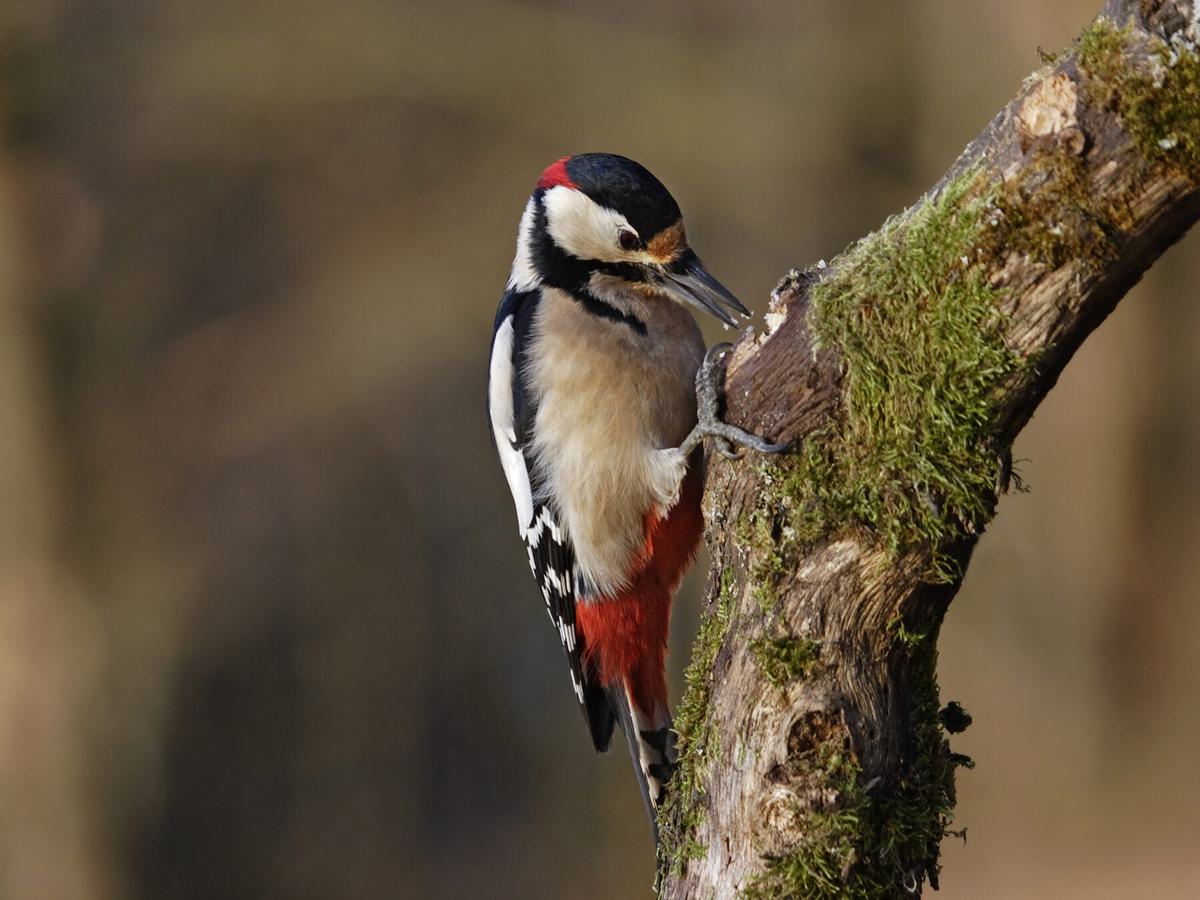
Great Spotted Woodpecker foraging for food
Where are the best places to see woodpeckers in the UK?
Great Spotted woodpeckers are relatively common in ancient, deciduous woodland. The older the woodland and the more rotting trees mixed into the environment, the better. Green woodpeckers are less common, but are also more likely to be seen in ancient woodlands.
Broadly speaking, Green woodpeckers, Great spotted woodpeckers and Little spotted woodpeckers share the same habitats.
As for wrynecks, rare sightings can occur practically anywhere, though the east coast seems more likely given that birds fly from Scandinavia to Africa. With that said, one was spotted near Bolton in 2020.
The best places to see woodpeckers in the UK are undoubtedly in the southeast of England. South Wales including the Brecon Beacons and Pembrokeshire are also good spots. Here’s a list of popular haunts for spotting woodpeckers:
- Buckinghamshire, Burnham Beeches
- Gloucestershire, Lower Woods and The Forest of Dean
- Leicestershire, Launde Woods
- London, Sydenham Hill Wood
- Hampshire, New Forest
- Oxfordshire, Warburg Nature Reserve
- Pembrokeshire, Pengelli Forest
- Warwickshire, Brandon Marsh
- Warwickshire, Oakley Wood

Green Woodpecker up a tree in the woods
What is the most common woodpecker in the UK?
The most common woodpecker in the UK is the Great Spotted woodpecker, with a population of 140,000 pairs.
The Green woodpecker is next, with around 52,000 pairs. Both are relatively common in the south of England and South Wales.
What is the largest woodpecker in the UK?
The Green woodpecker is the largest woodpecker in the UK, measuring up to 10cm longer than the Great Spotted woodpecker and weighing nearly double.
This strong, slender bird is relatively distinctive when you catch it swooping through the woods.
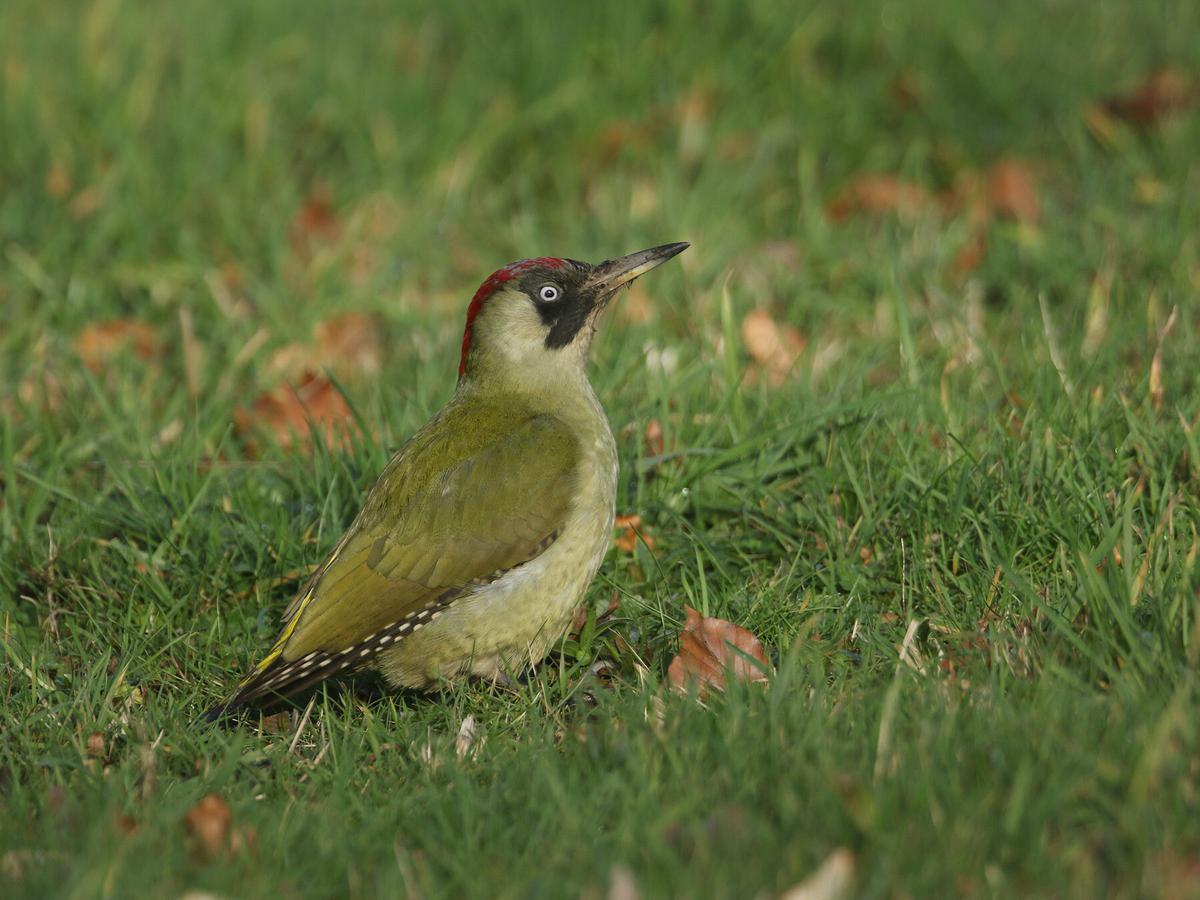
Green Woodpecker foraging on the ground for food
What is the smallest woodpecker in the UK?
The Lesser Spotted woodpecker is tiny, measuring less than 15cm. They weigh less than 26g. This makes them a similar size to a sparrow or small songbird.
As such, the Lesser Spotted woodpecker is extremely tough to spot given how rare it is.
How many types of woodpeckers are there in the UK?
There are three resident species of woodpeckers in the UK; the Green, Great Spotted and Lesser Spotted woodpeckers.
The rare wryneck doesn’t breed here and only visits infrequently during migration to and from Africa from northern Europe.
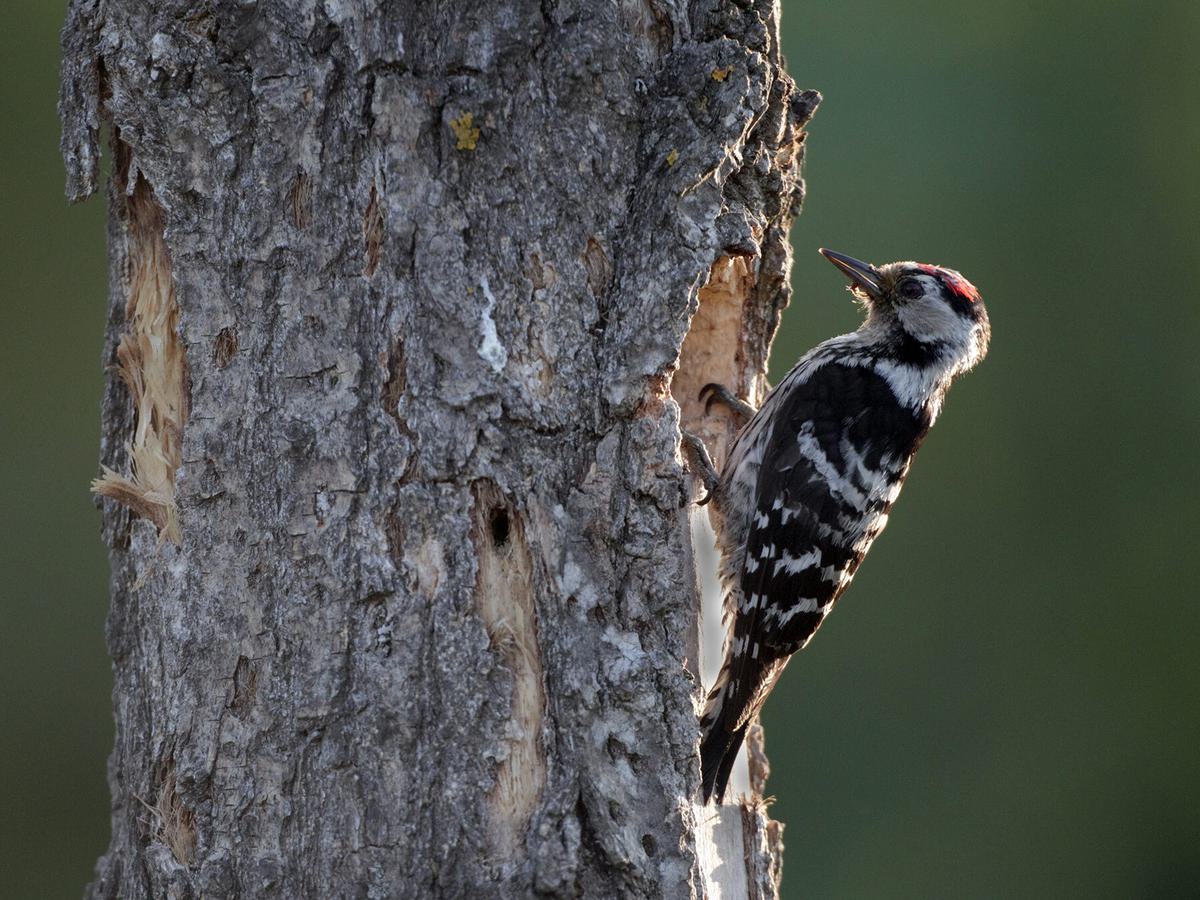
Lesser Spotted Woodpecker up a tree
What woodpeckers are native to the UK?
The Green, Great Spotted and Lesser Spotted woodpeckers are all native to the UK.
A rare vagrant, the Eurasian wryneck, was once native to the UK. However, the UK no longer has a self-sustaining population of breeding wrynecks.
Are woodpeckers protected in the UK?
All woodpeckers in the UK are protected under the Wildlife and Countryside Act 1981.
The Lesser Spotted woodpecker is a Red List species, and many conservation projects are aiming to support its dwindling population.
Are there woodpeckers in London?
Great Spotted and Green woodpeckers do occasionally frequent London’s parks and neighbouring woodlands.
For example, there have been sightings at Hyde Park and Regents Park. In fact, the urban and suburban populations of these two species of woodpeckers are increasing in the UK.
